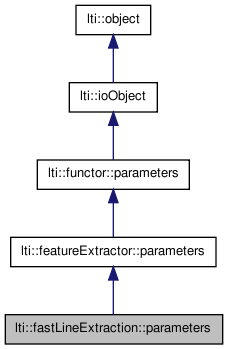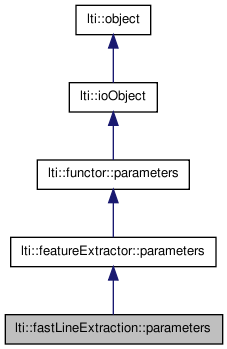

|
latest version v1.9 - last update 10 Apr 2010 |
|
the parameters for the class fastLineExtraction More...
#include <ltiFastLineExtraction.h>


Public Member Functions | |
| parameters () | |
| parameters (const parameters &other) | |
| ~parameters () | |
| const char * | getTypeName () const |
| parameters & | copy (const parameters &other) |
| parameters & | operator= (const parameters &other) |
| virtual functor::parameters * | clone () const |
| virtual bool | write (ioHandler &handler, const bool complete=true) const |
| virtual bool | read (ioHandler &handler, const bool complete=true) |
Public Attributes | |
| float | maxQuantizationError |
| int | segmentTolerance |
| int | maxSegmentGap |
| int | minLineLen |
| int | minSegmLen |
the parameters for the class fastLineExtraction
| lti::fastLineExtraction::parameters::parameters | ( | ) |
default constructor
Reimplemented from lti::featureExtractor::parameters.
| lti::fastLineExtraction::parameters::parameters | ( | const parameters & | other | ) |
copy constructor
| other | the parameters object to be copied |
Reimplemented from lti::featureExtractor::parameters.
| lti::fastLineExtraction::parameters::~parameters | ( | ) | [virtual] |
destructor
Reimplemented from lti::featureExtractor::parameters.
| virtual functor::parameters* lti::fastLineExtraction::parameters::clone | ( | ) | const [virtual] |
returns a pointer to a clone of the parameters
Reimplemented from lti::featureExtractor::parameters.
| parameters& lti::fastLineExtraction::parameters::copy | ( | const parameters & | other | ) |
copy the contents of a parameters object
| other | the parameters object to be copied |
Reimplemented from lti::featureExtractor::parameters.
| const char* lti::fastLineExtraction::parameters::getTypeName | ( | ) | const [virtual] |
returns name of this type
Reimplemented from lti::featureExtractor::parameters.
| parameters& lti::fastLineExtraction::parameters::operator= | ( | const parameters & | other | ) |
copy the contents of a parameters object
| other | the parameters object to be copied |
| virtual bool lti::fastLineExtraction::parameters::read | ( | ioHandler & | handler, | |
| const bool | complete = true | |||
| ) | [virtual] |
read the parameters from the given ioHandler
| handler | the ioHandler to be used | |
| complete | if true (the default) the enclosing begin/end will be also written, otherwise only the data block will be written. |
Reimplemented from lti::functor::parameters.
| virtual bool lti::fastLineExtraction::parameters::write | ( | ioHandler & | handler, | |
| const bool | complete = true | |||
| ) | const [virtual] |
write the parameters in the given ioHandler
| handler | the ioHandler to be used | |
| complete | if true (the default) the enclosing begin/end will be also written, otherwise only the data block will be written. |
Reimplemented from lti::functor::parameters.
This threshold constant defines the maximum mismatch between the found line segments and the estimated analog line.
The segment is discarded if its starting/finishing pixel differs more than maxQuantizationError from the estimated analog line. If this value is greater than 1.0 the line detection will also extract lines that are not completely straight, which may be useful for estimation of lines. possible values are
0.5 < maxQuantizationError
A high maxQuantizationError value will extract longer lines at the cost of precision. Low values result in better pixel matching but also in shorter lines. Best compromise between pixel matching and good detection is a value between 0.6 and 0.7 (the default is 1.0)
The maximum gap two line segments may have and still be considered segments of the same line.
This parameter changes the size of the searching window for line segments. Small sizes allow fast processing but may also cause detection failures (as well as too high values) A maxSegmentGap of 1 will only group contiguous segments to a line. possible values are
maxSegmentGap >= 1 (pixel)
Higher maxSegmentGap values also allow extraction of non-contiguous lines such as found in corrupted images. The default is 1
The minimum length a line must have to get extracted.
The parameter minLineLen is used as threshold, smaller lines will be ignored. possible values are
minLineLen >= 3 (pixel)
Values greater than 3 will strongly decrease the number of extracted lines. The default is 3
The minimum length a line segment must have to be detected.
The parameter minSegmLen is used as threshold, smaller segments will be ignored. Values greater than 2 strongly decrease the number of detected segments and the size of the segment lists. possible values are
minSegmLen >= 2 (pixel)
Values greater than 2 result in smaller segment lists and therefore allow slightly faster line detection. But mostly good line detection is more important than a small speedup, so don't change this parameter unless there is a good reason to do so. The default is 2
This constant defines how much the value of two adjacent pixels may differ and still be considered pixels of the same segment.
A segmentTolerance of 0 will only group pixels of the same value to one segment. When analyzing binary maps such as edge-images a value of 0 should be used. possible values are
0 <= segmentTolerance <= 254
Higher segmentTolerance values allow non-binary images to be analysed but may also result in wrong segment start/end detection. The default is 0